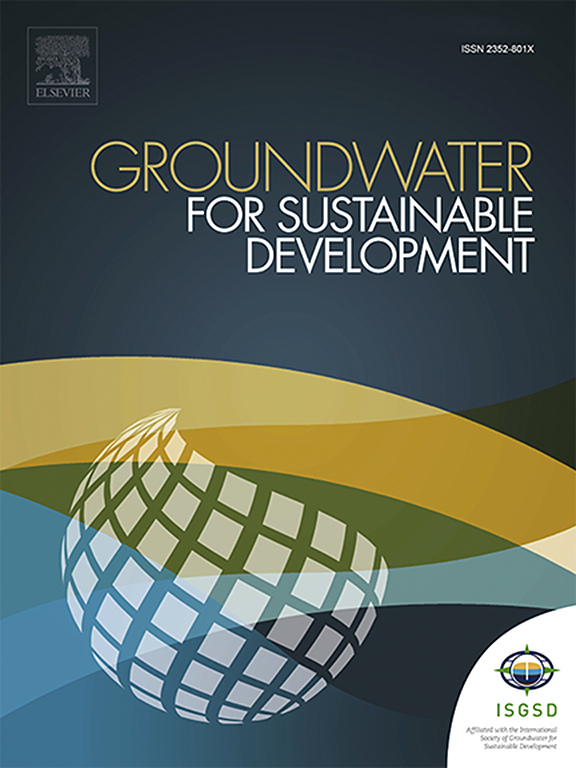Discrimination of potential groundwater areas using remote sensing, gravity and aeromagnetic data in Rey Bouba and environs, North Cameroon
IF 4.9
Q2 ENGINEERING, ENVIRONMENTAL
引用次数: 0
Abstract
Groundwater exploration is required in semi-arid to arid areas especially where the public water supply network is not available due to the lack of funds. The National Development Strategy of Cameroon 2020–2030 (NDS30) highly supports the sustainable development of each region from its own natural resources. In this regard, this study aims at the identification of potential groundwater resources from the application of Analytic Hierarchy Process (AHP) to remote sensing, gravity and aeromagnetic data in Rey Bouba and Environs. First and foremost, several critical parameters such as surface line density, gravity line density, magnetic line density, drainage density, slope, rainfall, topographic wetness index, topographic roughness index, soil, land use land cover and normalized digital vegetation index, were generated, assigned weights and merged to obtain the groundwater potential of the study area. As a result, 24.8 % of the study area exhibits very low and low groundwater potential while 71.93 % of the study area has moderate groundwater potential water. High and very high groundwater potential zones cumulate 3.27 % of the research area. Accordingly, considerable potential groundwater resources were identified in the vicinity of Sagdje, Bandjoukri, and Tchollire. The correlation of existing wells with the groundwater potential map shows that most productive wells are connected with moderate groundwater potential zones while most unproductive wells are linked to low groundwater potential areas. Furthermore, 3 profiles extracted from the potential field data were used to realize the 2D geological modeling. Hence, the subsurface geological architecture of the study area shows that the depth to the top of the basement or the depth to the bottom of the sedimentary cover varies from 100 to 2600 m, 100–2700 m and 0–1400 m for profiles P1, P2, and P3, respectively.

利用遥感、重力和航磁数据在喀麦隆北部雷布巴及其周边地区判别潜在地下水区
在半干旱至干旱地区,特别是由于缺乏资金而无法提供公共供水网络的地区,需要进行地下水勘探。《喀麦隆2020-2030年国家发展战略》(NDS30)高度支持每个地区利用其自然资源实现可持续发展。为此,本研究旨在将层次分析法(AHP)应用于Rey Bouba和Environs的遥感、重力和航磁数据中,识别潜在的地下水资源。首先,生成地表线密度、重力线密度、磁力线密度、排水密度、坡度、降雨量、地形湿度指数、地形粗糙度指数、土壤、土地利用、土地覆被和归一化数字植被指数等关键参数,赋值权重并合并得到研究区地下水潜力。结果表明,24.8%的研究区地下水潜力极低、低,71.93%的研究区地下水潜力中等。地下水高、特高潜势区占研究区总面积的3.27%。因此,在Sagdje、Bandjoukri和Tchollire附近发现了相当大的潜在地下水资源。现有井与地下水势图的对比表明,大部分生产井位于地下水势中位区,而大部分不生产井位于地下水势低位区。利用位场数据提取的3条剖面进行二维地质建模。因此,研究区地下地质构造表明,P1、P2、P3剖面基底顶部深度为100 ~ 2600 m,沉积盖层底部深度为100 ~ 2700 m,沉积盖层底部深度为0 ~ 1400 m。
本文章由计算机程序翻译,如有差异,请以英文原文为准。
求助全文
约1分钟内获得全文
求助全文
来源期刊

Groundwater for Sustainable Development
Social Sciences-Geography, Planning and Development
CiteScore
11.50
自引率
10.20%
发文量
152
期刊介绍:
Groundwater for Sustainable Development is directed to different stakeholders and professionals, including government and non-governmental organizations, international funding agencies, universities, public water institutions, public health and other public/private sector professionals, and other relevant institutions. It is aimed at professionals, academics and students in the fields of disciplines such as: groundwater and its connection to surface hydrology and environment, soil sciences, engineering, ecology, microbiology, atmospheric sciences, analytical chemistry, hydro-engineering, water technology, environmental ethics, economics, public health, policy, as well as social sciences, legal disciplines, or any other area connected with water issues. The objectives of this journal are to facilitate: • The improvement of effective and sustainable management of water resources across the globe. • The improvement of human access to groundwater resources in adequate quantity and good quality. • The meeting of the increasing demand for drinking and irrigation water needed for food security to contribute to a social and economically sound human development. • The creation of a global inter- and multidisciplinary platform and forum to improve our understanding of groundwater resources and to advocate their effective and sustainable management and protection against contamination. • Interdisciplinary information exchange and to stimulate scientific research in the fields of groundwater related sciences and social and health sciences required to achieve the United Nations Millennium Development Goals for sustainable development.
 求助内容:
求助内容: 应助结果提醒方式:
应助结果提醒方式:


